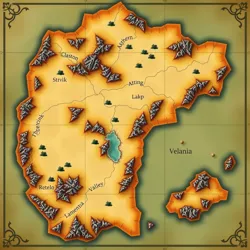Echo Mapping

Echo Mapping is an innovative cartographic technique developed to capture the dynamic and ephemeral landscapes of regions like Lamentia. This method was pioneered by the Unseen Cartographers to address the challenge of documenting areas where the geography is in constant flux. Echo Mapping captures the 'echoes' of the land, which are subtle reflections of its changes over time, providing a more accurate representation of its current state.
Development and Methodology
Echo Mapping emerged as a response to the unique challenges posed by landscapes that defy traditional mapping techniques. The Unseen Cartographers, renowned for their mystical approach to cartography, developed this technique by combining traditional mapping skills with new, intuitive methods.
The process involves "listening" to the land through a combination of auditory and visual cues. Cartographers use specialized equipment to detect and record the natural resonances of the environment. These echoes are then translated into visual data, illustrating the land's current form and potential shifts.
Application in Lamentia
Lamentia, with its ever-shifting geographical features, serves as the perfect canvas for Echo Mapping. The technique allows cartographers to not only map the physical characteristics of the land but also to reflect its emotional and cultural essence. This has proven invaluable for understanding the land's influence on the Lamentian culture, where music and storytelling are deeply connected to the landscape.
Echo Mapping has been instrumental in uncovering hidden areas such as the "Valley of Echoes" and "Silent Lake." These discoveries have enriched the cultural and academic appreciation of Lamentia, offering new insights into its mystical properties.
Impact on Cartography
The introduction of Echo Mapping has significantly influenced the field of cartography, offering a new dimension to the study of landscapes. It challenges the static nature of traditional maps by presenting a more fluid and responsive portrayal of the environment. This approach has inspired other cartographers to explore the emotional and temporal aspects of the areas they map.
Echo Mapping has also opened up new avenues in the study of the relationship between geography and emotion, providing empirical data that supports the longstanding belief in the interconnectedness of land and memory.
Future Prospects
The potential applications of Echo Mapping extend beyond Lamentia. As cartographers refine the technique, it could be used to explore other dynamic environments, particularly those affected by climate change or geological activity. The ability to capture the 'echoes' of a landscape could provide valuable insights into its resilience and transformation over time.
Moreover, Echo Mapping may hold the key to understanding the emotional impact of geography on human experience, a field that continues to intrigue scholars and artists alike.
See Also
- Unseen Cartographers
- Lamentia
- Valley of Echoes
- Silent Lake
References
- "Echo Mapping: A New Frontier in Cartography," Cartographic Innovations Quarterly.
- "Dynamic Landscapes: Mapping the Unseen," Journal of Geographical Studies.
- "The Emotional Geography of Lamentia," Cultural Cartography Review.